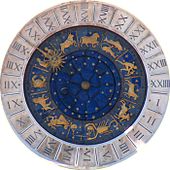| Gemini | |
|---|---|
 | |
| Zodiac symbol | Twins |
| Duration (tropical, western) | May 20 – June 20 (2024, UT1)[1] |
| Constellation | Gemini |
| Zodiac element | Air |
| Zodiac quality | Mutable |
| Sign ruler | Mercury |
| Detriment | Jupiter |
| Exaltation | North Node |
| Fall | South Node |
| Astrology |
|---|
 |
| Background |
| Traditions |
| Branches |
| Astrological signs |
| Symbols |
Gemini (♊︎) (/ˈdʒɛmɪnaɪ/ JEM-in-eye [2] Greek: Δίδυμοι, romanized: Dídymoi, Latin for "twins") is the third astrological sign in the zodiac. Under the tropical zodiac, the sun transits this sign between about May 21 to June 21.[3] Gemini is represented by the twins, Castor and Pollux,[4] known as the Dioscuri in Greek mythology. It is known as a positive, mutable sign.





